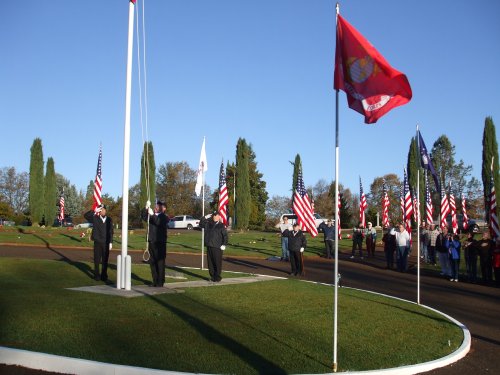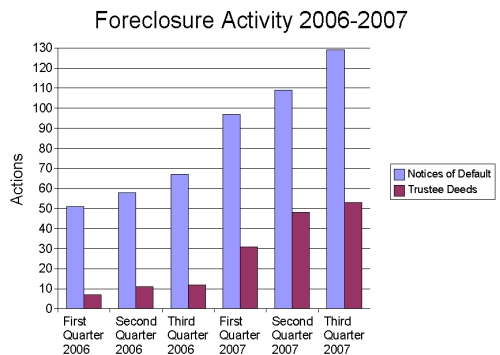LAKE COUNTY – The first successful Congressional override of a veto in the Bush presidency will have direct impact on Lake County, with the bill in question authorizing an ecosystem restoration project.
President George W. Bush vetoed HR 1495, The Water Resources Development Act (WRDA) of 2007, on Nov. 2.
In his veto message to Congress Bush said the bill “lacks fiscal discipline,” authorizing over 900 projects and programs at a cost of $23 billion, with another $38 billion in appropriations necessary to complete all the projects in the future.
Bush added that the bill failed to set priorities, and should have focused on projects with “the greatest merit.” He said it will hinder the Army Corps of Engineers' ability to pursue critical projects in providing greater hurricane protection for New Orleans, flood reduction in Sacramento and restoration in the everglades.
However, with no WRDA bill passing in seven years, Congress acted to hand Bush the first veto override of his presidency.
On Tuesday, the House of Representatives voted to override Bush's veto in a bipartisan 361-54 vote, according to Congressional records.
On Thursday morning, the Senate followed suit, overriding the veto in a 79-14 vote, with seven senators not voting.
Congressman Mike Thompson, who voted in favor of the House's override, greeted the Senate's action with enthusiasm on Thursday.
"The past three Congresses failed to pass WRDA, and when the new majority in Congress made sure its passage was a top priority, the president vetoed it,” said Thompson. “Fortunately, Congress voted to override the president's veto with a strong, bipartisan majority. Communities across the country have waited too long to repair aging infrastructure that’s putting their residents and businesses at risk.”
He took aim at the president's claims about the bill being “fiscally irresponsible,” saying the bill “does not spend one cent.”
“It is a multi-year authorization bill; spending only occurs when Congress later appropriates funds for projects,” Thompson explained.
“Much of our nation’s flood control and navigation infrastructure is out of date,” said Thompson. “Many environmental restoration projects are struggling with inadequate funding. This bill authorizes the government to spend the money necessary to keep our communities safe. It’s an excellent example of how this Congress is working to address the priorities of the American people.”
What it means to Lake County
One of the projects authorized, but not funded, in WRDA's 2007 version is the Middle Creek Ecosystem Restoration Project in the Northshore area.
The project will restore 1,200 acres of wetlands and 500 acres of floodplain in the Clear Lake area, as Lake County News has previously reported.
The project calls for reconnecting the Scott’s Creek and Middle Creek to the historic Robinson Lake wetland and floodplain. These two watersheds provide 57 percent of the water flow into Clear Lake.
Bob Lossius, Lake County's assistant director of Public Works, said the project is very important to Lake County, and has never been this far along before.
With the bill becoming law, it will authorize the project, which Lossius said is critical to getting the federal, state and private funds needed to complete the work.
“It's another step in keeping the project going,” he said.
He added, “The next step will be for Congressman Thompson and others to get us appropriations in appropriations bills to fund this project at the federal level.”
The total project is estimated to cost about $45 million, said Lossius. The federal government will only cover 65 percent of that amount, so the remaining 35 percent – just under $16 million – must come from state and local sources, including nonprofit groups and private donations.
WRDA itself, said Lossius, only authorizes Middle Creek. “It doesn't commit a single dime to it.”
Lossius added that the county already has a $5 million grant to go toward property acquisition, which can be used as a match to that local funding requirement.
“We'll keep plugging along, going after grants,” he said.
At the state level, the county will work with Sen. Patricia Wiggins and Assemblywoman Patty Berg to get the state to agree to implementing the project. If the state does agree, said Lossius, there is a 50-percent chance of getting up to 50 percent of that $16 million non-federal share.
With WRDA's authorization, state legislation to get the state reclamation board's participation is another item on the to do list, said Lossius.
He said the county also hopes that nonprofit groups will be willing to donate funding to push the project forward.
A lengthy process still ahead
Middle Creek already has a lengthy history, said Lossius.
In 1989, Tom Smythe, an engineer with the county's Water Resources Division, suggested fully restoring an 80- to 90-acre area of land along the Nice-Lucerne Cutoff that is now being transformed into an organic rice field. The owner at the time, however, was not willing to sell, said Lossius.
In 1994, the county, the state Department of Water Resources, property owners and the Army Corps of Engineers met to discuss the area's deteriorating levees, and what could be done to stop flooding.
The Army Corps of Engineers suggested the ecosystem restoration as the best method to improve water quality, benefit wildlife and reduce floods in the Middle Creek area, said Lossius.
In 1997, the Army Corps of Engineers completed a reconnaissance study on the program, Lossius explained. The study was to look at the best options for addressing all of the problems.
The Army Corps of Engineers then conducted environment and feasibility studies beginning in 1999. Those studies were completed in 2004, said Lossius, and cost about $1.5 million, with the county receiving $400,000 in grants to go toward the project, and the state adding another $400,000.
The Corps' conclusion, said Lossius, was that the full Middle Creek restoration was the best of about six alternatives analyzed. The Army Corps chief proposed it in his report to Congress in November 2004.
Then they had to wait three years for a WRDA bill, which takes the project to the next step, said Lossius.
The county, for several years, has been setting aside $400,000 in matching funds for the project's phase one design, said Lossius. “We've been putting it aside for the last three, four years, hoping that this thing would get authorized so we could move forward with design.”
The design's phase one actually will be split into three phases of its own to give the county the opportunity to get together the needed funds, Lossius explained.
Project design will cost between $2 million and $3 million total, said Lossius. The county already has an agreement with the Army Corps of Engineers to start the design once authorization and appropriation of the funds are in place.
About 13 homes still need to be moved out of the area – seven already have been moved, said Lossius – and 35 acres of Pomo land that will be flooded are still at issue. Lossius said the tribe has other land it would like to transfer into trust instead, but that has not yet been settled.
Restoring wetlands will improve water quality by filtering sediments out of the floodwaters that come out of the Scotts Creek and Middle Creek watersheds, said Lossius.
The project also will result in returning the area of Bloody Island – called Bo-No-Po-ti in the Pomo language – to an actual island once more when the lake is full, said Lossius.
So, how quickly could the project become a reality?
“The absolute best, if they appropriated at the federal level all of the funds and we had all of the non-federal funds available, it's going to take another three years just to get the design done,” said Lossius.
It would then move to construction, said Lossius. His best guess for the quickest completion would be five years.
However, realistically, it's more likely 10 to 15 years to get such a project completed, he said.
E-mail Elizabeth Larson at This email address is being protected from spambots. You need JavaScript enabled to view it..
{mos_sb_discuss:2}











